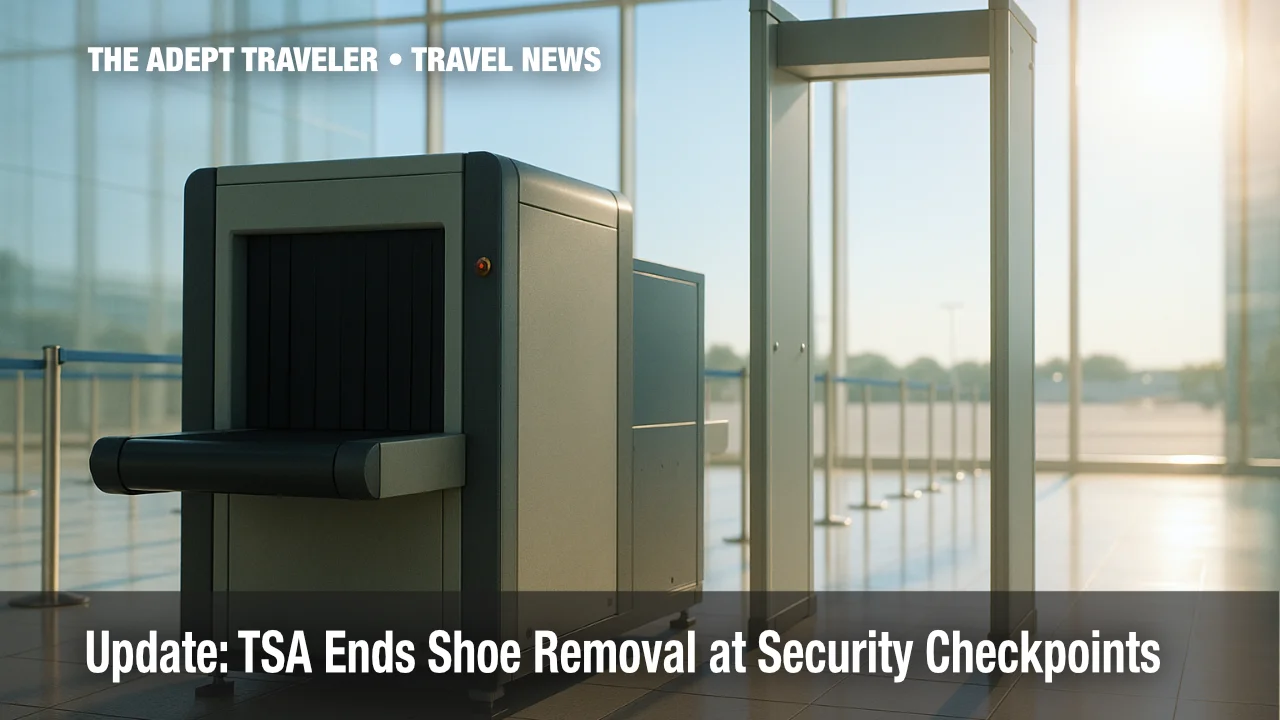Update; TSA Ends Shoe Removal at U.S. Airport Security Checkpoints

Travelers clearing U.S. airport security can finally leave their shoes on. Homeland Security Secretary Kristi Noem confirmed the long-awaited change, immediately cancelling the Transportation Security Administration's 19-year "shoes-off" rule. The order takes effect nationwide and reflects confidence that modern body scanners and CT X-rays can detect concealed threats without extra hassle. Some airports had already piloted the practice, and our earlier coverage previewed the shift. Now the agency's decision is official and permanent.
Key Points
- Why it matters: Screening lines should move up to 30 percent faster this summer.
- Policy is in effect at every U.S. checkpoint.
- Officers may still request shoe removal during secondary checks.
- TSA PreCheck keeps perks like leaving liquids and electronics packed.
Snapshot
The "shoes-off" rule began in 2006 after a bombing attempt. Since then, most passengers have balanced on cold floors, while PreCheck members enjoyed keeping footwear on. Today's decision erases that divide. TSA says every U.S. checkpoint now has either millimeter-wave body scanners or CT carry-on scanners capable of spotting sole-level threats. Travelers should still arrive early because other screening steps-identity checks, 3-1-1 liquid limits, and occasional pat-downs-remain unchanged. Families with children, older adults, and travelers with medical devices are expected to see the greatest comfort gains. Airport operators anticipate shorter queues and fewer abandoned bins to clear.
Background
The shoe requirement took hold after Richard Reid hid explosives in his footwear aboard an international flight in December 2001. By August 2006, TSA added shoe removal to its standard procedures, arguing that X-ray systems of the day could not reliably penetrate dense midsoles. Limited exemptions existed for children under 12, travelers over 75, and some with medical conditions. The 2013 launch of TSA PreCheck introduced a formal "shoes on" lane for vetted, low-risk travelers and helped the program surpass 20 million members. Over the past decade, airports gradually installed millimeter-wave body scanners and CT carry-on machines, each capable of 3-D imaging. Internal studies showed detection rates comparable to manual shoe X-rays, setting the stage for the new policy.
Latest Developments
The Department of Homeland Security's new directive took effect nationwide the moment Secretary Noem spoke. Implementation relies on technology already in place and does not require new hardware purchases.
Immediate Rollout
Every federalized checkpoint received updated software instructions overnight on July 7-8. Officers were briefed during morning roll-calls and signage was swapped before the first departure banks. TSA's command center will monitor wait times daily to gauge the rule's practical impact and release metrics this fall.
Technology Driving the Change
Millimeter-wave portals detect anomalies against a generic body outline, even inside thick footwear. Meanwhile, CT scanners rotate carry-on bags through 360 degrees, building a voxel-level model that highlights potential threats in color. TSA officials said combined data from both systems renders mandatory shoe removal redundant. The agency also noted that footwear construction trends-lighter foams and recycled plastics-improve scanner penetration compared with 2006 materials.
PreCheck Still Pays Off
Noem emphasized that PreCheck "continues to save time" because participants may leave belts, compliant liquids, and laptops in place. PreCheck lanes will retain shorter queue standards-under 10 minutes-while standard lanes aim for 30 minutes or less. TSA expects some travelers to question the $78 five-year fee, yet believes the bundle of conveniences remains attractive, especially during peak holiday travel and the 2026 World Cup rush. Enrollment centers will highlight the new shoe parity while marketing the lane-speed advantage.
Analysis
For travelers, the most immediate benefit is comfort. Passengers no longer juggle bins, children, and carry-ons while untying or re-lacing footwear. Airports forecast smoother throughput because each saved action compounds across thousands of passengers per hour. Staffing models suggest agents can redirect time from coaching travelers to secondary inspections, potentially reducing false alarms and improving threat focus. Airlines, facing record summer loads, welcome the change, expecting fewer missed connections caused by long security delays. However, some concerns remain. Secondary screening discretion means anyone triggering an alarm, wearing very thick soles, or traveling with medical orthotics might still be asked to remove shoes, so travelers should still choose easily removable pairs. PreCheck's value proposition narrows, yet seasoned travelers often cite the lane's predictability as worth the price-especially as other protocols evolve.
Final Thoughts
The end of mandatory shoe removal marks TSA's biggest visible change since liquid limits. It signals an agency ready to trade blanket rules for risk-based, tech-enabled judgment. Travelers should still confirm checkpoint rules before flying but can now pack socks without dreading the floor. As scanner capabilities grow, officials hint that belt and jacket rules could be next for review. For now, faster lines, warmer toes, and fewer misplaced shoes add up to a welcome win-cementing the new, traveler-friendly TSA shoe removal policy.
